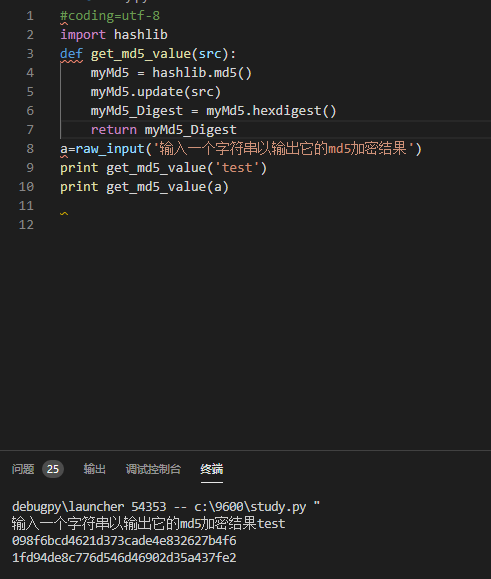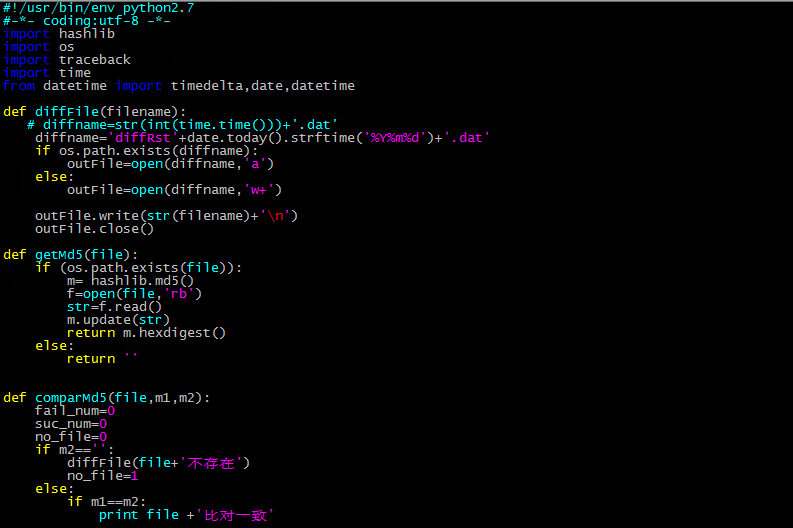

#Python module for md5 encoding code
Next UTF-8-encoded code point and resynchronize. If bytes are corrupted or lost, it’s possible to determine the start of the UTF-8 is fairly compact the majority of commonly used characters can be Through protocols that can’t handle zero bytes for anything other thanĪ string of ASCII text is also valid UTF-8 text. That UTF-8 strings can be processed by C functions such as strcpy() and sent

Zero bytes only where they represent the null character (U+0000). If the code point is = 128, it’s turned into a sequence of two, three, orįour bytes, where each byte of the sequence is between 128 and 255.Ī Unicode string is turned into a sequence of bytes that contains embedded Used than UTF-8.) UTF-8 uses the following rules: (ThereĪre also UTF-16 and UTF-32 encodings, but they are less frequently UTF stands for “Unicode Transformation Format”,Īnd the ‘8’ means that 8-bit values are used in the encoding. UTF-8 is one of the most commonly used encodings, and Python oftenĭefaults to using it. Therefore this encoding isn’t used very much, and people instead choose otherĮncodings that are more efficient and convenient, such as UTF-8. It’s not compatible with existing C functions such as strlen(), so a newįamily of wide string functions would need to be used. Increased RAM usage doesn’t matter too much (desktopĬomputers have gigabytes of RAM, and strings aren’t usually that large), butĮxpanding our usage of disk and network bandwidth by a factor of 4 is The above string takes 24 bytes compared to the 6 bytes needed for anĪSCII representation. In most texts, the majority of the code pointsĪre less than 127, or less than 255, so a lot of space is occupied by 0x00īytes.
#Python module for md5 encoding portable
It’s not portable different processors order the bytes differently. This representation is straightforward but using it presents a number of The first encoding you might think of is using 32-bit integers as theĬode unit, and then using the CPU’s representation of 32-bit integers. Sequence of bytes are called a character encoding, or just The rules for translating a Unicode string into a Memory as a set of code units, and code units are then mapped This sequence of code points needs to be represented in To summarize the previous section: a Unicode string is a sequence ofĬode points, which are numbers from 0 through 0x10FFFF (1,114,111ĭecimal). Glyphs figuring out the correct glyph to display is generally the job of a GUI Most Python code doesn’t need to worry about Is two diagonal strokes and a horizontal stroke, though the exact details willĭepend on the font being used. The glyph for an uppercase A, for example, Informal contexts, this distinction between code points and characters willĪ character is represented on a screen or on paper by a set of graphicalĮlements that’s called a glyph. U+265E is a code point, which represents some particularĬharacter in this case, it represents the character ‘BLACK CHESS KNIGHT’, Strictly, these definitions imply that it’s meaningless to say ‘this isĬharacter U+265E’. The Unicode standard contains a lot of tables listing characters and Using the notation U+265E to mean the character with value In the standard and in this document, a code point is written A code point value is an integer in the range 0 to The Unicode standard describes how characters are represented byĬode points. They’ll usually look the same,īut these are two different characters that have different meanings. For example, there’s a character for “Roman Numeral One”, ‘Ⅰ’, that’s Characters varyĭepending on the language or context you’re talkingĪbout. ‘A’, ‘B’, ‘C’,Įtc., are all different characters. Revised and updated to add new languages and symbols.Ī character is the smallest possible component of a text. The Unicode specifications are continually List every character used by human languages and give each character Unicode ( ) is a specification that aims to Python’s string type uses the Unicode Standard for representingĬharacters, which lets Python programs work with all these different These languages and can also include a variety of emoji symbols. Same program might need to output an error message in English, French, Messages and output in a variety of user-selectable languages the Applications are often internationalized to display Today’s programs need to be able to handle a wide variety ofĬharacters. People commonly encounter when trying to work with Unicode. This HOWTO discusses Python’s support for the Unicode specificationįor representing textual data, and explains various problems that


 0 kommentar(er)
0 kommentar(er)
